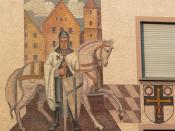Medieval times were the popular birthplace of heroic knights and fleeting art known as chivalry. If we close our eyes we can envision a knight, such as Sir Lancelot, dashing in on his white stallion, to the rescue of his damsel in distress. Our minds let us see the monstrous castle in the midst of a lush green countryside. We are swept to a far away time of gallantry and romance. We drift to a magical place of faith and love, courtesy and heroism as we imagine medieval knights and chivalry.
To understand such romance, one must know the definition of chivalry and knighthood. "Chivalry comes from the French Chevalerie, from Chevalier or Knight (Law Latin Caballus for horse)."� Chivalry is an honor code that pledges a knight to honor, respect and defend ladies. Chivalry goes hand in hand with virtue, courtesy, piety, and honor. "Knighthood comes from the English word knight, which means household retainer."�
Knights were not only dedicated to females, but had much faith and would defend and die for their birth land. Originally, knights were basically professional soldiers on horseback Knighthood emerged in the 11th century, the members being noble men of great land owning families. Anyone who could manage to obtain the training and equipment could enter the class of knighthood. Many could not uphold the position for the cost of upkeep of the horses and equipment was more than they could afford. Men who were not free to enter knighthood provided a portion of their crops and labor services. In the 12th century, chivalric codes were added to knighthood. Soldiers had to train and practice daily on self-defense and control of mind, body and speech. Chivalry added discipline to knighthood.
A knight usually served an apprenticeship as a Page. Sometimes he would...


